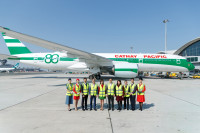Money
Wage gap between men and women persists, report says
The widest difference is in the professional category where a male worker earns Rs23,800 monthly compared to Rs12,000 for a female.
Krishana Prasain
Last December, the All Nepal Football Association made a landmark decision to end wage discrimination between men and women national players, and pay them the same salary starting January 2021.
Nepal thus became one of the few countries in the world to end pay disparity in sports. But in most other sectors, there is still a wide wage gap between female and male workers, according to a recent study report unveiled by the Central Bureau of Statistics.
An analytical report on Women in Business shows that the share of women workers in any sector is high when the monthly income is small and vice versa.
The share of women workers is 58 percent for monthly incomes smaller than Rs7,600. In contrast, the share of women workers is only 12.2 percent for monthly incomes of more than Rs25,000.
The Central Bureau of Statistics, the central agency for the collection, consolidation, processing, analysis, publication and dissemination of data in Nepal, reports that the biggest pay gap between male and female workers is in the "professional" category. In this category, for example, if a male earns Rs23,800 monthly, a female earns Rs12,000.
Even in the “managers” category, which requires competency, if a male earns Rs32,000 per month, the pay for women averages Rs25,500.
The pay gap in the “technicians and associated professionals” category is not so great— the monthly salaries for men and women being Rs24,000 and Rs22,500 respectively. In the “agriculture, forestry and fisheries workers” category too, if a male earns Rs12,167 monthly, female workers earn Rs11,406.
“One of the reasons why the cash income of females is less than that of male workers would be that not many female workers take up leadership positions and professional occupations,” the report said. “Another reason is that the income of female workers is smaller than that of male workers even when they are in the same positions.”
To achieve the Sustainable Development Goals of the United Nations, the bureau has recommended that a collection of 17 interlinked global goals be designed to be a blueprint to achieve a better and more sustainable future for all. On gender equality and women empowerment, it would be important to get a clear understanding of the situation of women participation in political, economic and public activities.
Kushum Shakya, professor and former head of the Central Department of Economics at Tribhuvan University, said that social barriers and education were the key hindrances for women from participating in different business activities, including the gender pay gap.
“Most women quit their careers soon after starting a family. This reduces their participation in higher positions,” said Shakya. “Women are also forced to quit their education halfway due to various pressing reasons. So, with a low level of education, they remain at the lower levels in their professional career,” she said.
Shakya said that there was a huge payment disparity in the private sector. “The government should make a provision for an equal pay system. The pay disparity is the single biggest reason for discouraging women from participating in working and their professional growth,” she said.
The major problems of gender equality in Nepal, as pointed out by the Fifteenth Plan (2020-21 to 2024-25), include prevalence of behavioural discrimination against women, and the persistence of societal structures, beliefs, values and traditional practices that promote illiteracy, harmful practices, gender-based discrimination and violence against women.
Nepali women ranked second in South Asia and 101st globally in the Global Gender Gap Report 2020. The Global Gender Gap Index showed that Nepal was ranked high on political empowerment while placed at lower positions on educational attainment and health and survival.
The Fifteenth Plan has made strategies such as responsive budgets at all levels of government for the institutionalisation of gender, and for the achievement of economic empowerment and social transformation by giving special priority to economically poor and socially excluded women to achieve substantial gender equality by ensuring equal and meaningful participation of women.
Bhawani Rana, immediate past president of Federation of Nepalese Chambers of Commerce and Industry, the apex private sector body of Nepal, said that women were gradually becoming leaders—mostly in the business sector.
“A patriarchal culture, access to finance, lack of technical knowledge and traditional methods of production are barriers for women entrepreneurs to move ahead,” Rana said. "As most women are engaged in informal business sectors, which are not registered, their economic contribution is not counted or is not visible in the statistics,” she added.
Despite government efforts, gender disparities in Nepal have not been fully eliminated as women are backward in terms of literacy, property rights and labour participation, the report showed.
According to the report, the women's literacy rate of 57.7 percent is lower than that of men by 20 percentage punts, the proportion of women with access to property right is only 26 percent, and labour participation of women is 26.3 percent compared to 53.8 percent for men.
In terms of societal aspects, women are disproportionately more involved in unpaid housework than men, the analytical report said.
According to the report, there are 273,436 female managers, or 29.6 percent, compared to 648,773 male managers who make up 70.3 percent of the total.
From agriculture, forestry and fishing to manufacturing, wholesale and retail trade, accommodation and food service activities, financial and insurance activities, professional, scientific and technical activities, education, human health and other social activities, the number of male managers is higher than that of females, the report said.
There are 77.6 percent male managers in the manufacturing sector against only 22.2 percent female managers. In the financial and insurance sectors, there are 75 percent male managers and only 24.7 percent female managers.
The gender gap in the information and communication sector is even wider, with male managers making up 89 percent and female managers accounting for only 9.8 percent.
According to the report, the participation of women at decision-making levels in the private sector is 29.61 percent. Similarly, women’s participation in the cooperative sector is 51 percent.
The report said that 98.3 percent of female managers were engaged in 268,866 micro establishments that engage 1-9 people. The scale of the businesses established by female managers is small compared to male managers.
The report said that the average annual sales of a company run by female managers was Rs1 million, compared to Rs4.1 million for male managers. Similarly, the annual average profit of companies run by female managers is Rs343,000, compared to Rs1.2 million for male managers.
The access to credit of male managers is 36.1 percent and that of female managers 34.3 percent, according to the report. The major loan providers to businesses with female managers are cooperatives with 36.4 percent while the major loan providers to businesses with male managers are banks with 39.6 percent.
There are 1.2 million female employees, accounting for 37.7 percent of the workforce while the figure for male employees is 2 million, or 62.3 percent, the report shows.
More women are engaged in human health and social work activities with 56.8 percent compared to 43.2 percent for men.




 6°C Kathmandu
6°C Kathmandu















